Contributory members are able to log private notes and comments about each site
Sites Anne T has logged. View this log as a table or view the most recent logs from everyone
King Edward's Monument
Trip No.40 Entry No.7 Date Added: 22nd Aug 2017
Site Type: Cairn
Country: England (Cumbria)
Visited: Yes on 20th Aug 2017. My rating: Condition 3 Ambience 4 Access 4

King Edward's Monument submitted by Anne T on 22nd Aug 2017. First view of the monument from the parking area at NY 32876 60329
(View photo, vote or add a comment)
Log Text: King Edward's Monument, Burgh-by-Sands: After having visited Beaumont, I was reluctant to go home without seeing something of the Solway, and looking across to Dumfries & Galloway, where we spent 12 years. When we last visited in February 2014 we were unable to get down the lane because it was so waterlogged (we got about one third of the way down and had to abandon the visit, having seen the monument only from afar). This time, the lane looked dry, so we parked by the little triangle of grass and could see the monument on the marshland below.
Appearances were certainly deceptive – parts of the lane were ankle deep in mud, and we picked our way from the track to the marshy grass land next to it, to dry stones and boulders where we could. Eventually we came to the stile over a small stream at NY 32773 60897, which led immediately down to a small wooden bridge and onto another stile. The other side of this stile was deep in water, but thankfully previous walkers had moved ‘stepping stones’ into the water. Once onto Burgh Marshes, the mounds left by ridge and furrow ploughing kept our feet dry until we got to the monument. Parts by the brick wall/metal railings surrounding the monument looked as if it was surrounded by a small moat!
What a place to have waited to cross the Solway. I think I would have preferred to have seen the original cairn rather than this Victorian monstrosity. The chimneys of Chapelcross, the decommissioned nuclear power plant, could be seen across the estuary, together with the flattened hilltop of Burnwark hillfort.
At the time of our visit, the tide was out, but I could imagine the shimmering water of the Solway to the west. A fitting end to a nice afternoon out.
St Mary's Church (Walton)
Trip No.40 Entry No.1 Date Added: 22nd Aug 2017
Site Type: Ancient Cross
Country: England (Cumbria)
Visited: Yes on 20th Aug 2017. My rating: Condition 3 Ambience 3 Access 5

St Mary's Church (Walton) submitted by Anne T on 22nd Aug 2017. Standing nearer to the south western corner of the church looking back at the cross shaft. The stone is badly shattered and spalled off on this side.
(View photo, vote or add a comment)
Log Text: St. Mary's, Walton: Went to see a cross head, but found an 11th century market cross instead! This is a very pretty little village, and was on our way back to Stapleton to try to find the Bride’s Well (ran out of time last Thursday). We parked opposite the church on the side of the village green and walked across to the church, letting ourselves in through the rather rusty gate (it took us ages to work out how to open it). I excitedly followed my husband into the church but stopped dead as there was no sign of the cross head at all.
We hunted under pews, up and down the aisles, on window ledges, around the font, inside a chest, and all the places we could think of. The only sign of the cross was a photograph and a brief description on the display boards against the north western wall of the nave, which showed it displayed on top of the font cover. (I’ve since sent an email to the vicar to enquire where it might be located or moved to, but not had a reply yet).
We did however, see a paragraph on the display boards headed AD850 to 1066: “During the latter part of the 9th century to the middle of the 11th century, Walton, as a community, developed. The evidence for this is shown by the relics found in or around the present church. Between the years of 850 to 950, a preaching cross was erected and similarly between 1000 and 1050, a market cross was probably erected.” There is an image of the remains of the market cross in the churchyard. We then went to find this, disappointed not to have found the cross head, but pleased there was something of antiquity to have made this detour worthwhile.
St Andrew's Well (Kirkandrews-on-Eden)
Trip No.40 Entry No.6 Date Added: 22nd Aug 2017
Site Type: Holy Well or Sacred Spring
Country: England (Cumbria)
Visited: Yes on 20th Aug 2017. My rating: Condition 3 Ambience 4 Access 4
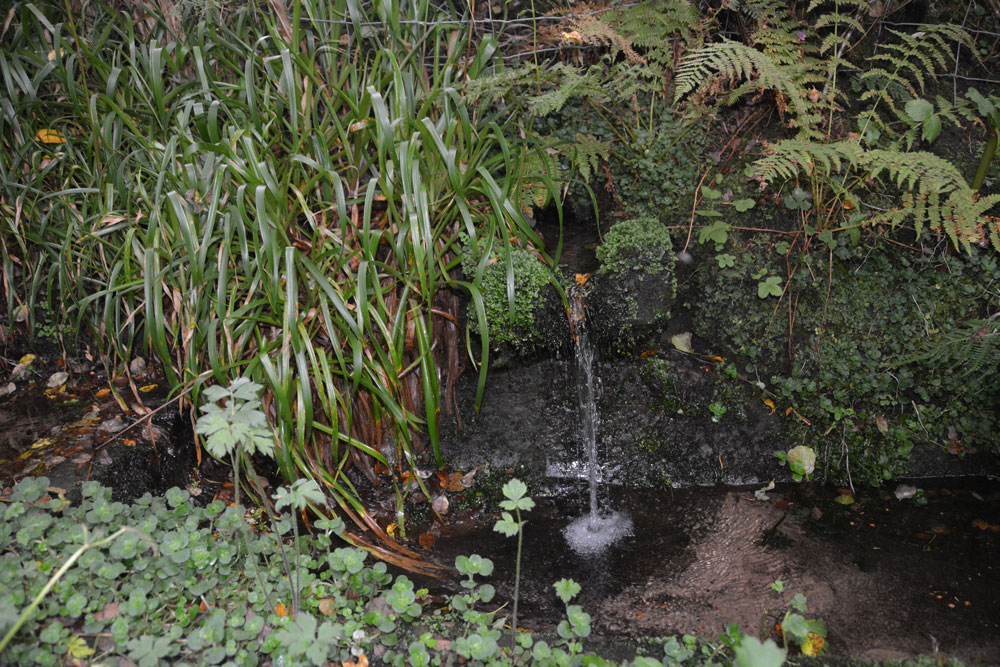
St Andrew's Well (Kirkandrews-on-Eden) submitted by Anne T on 22nd Aug 2017. Standing looking at the bank where the spring emerged, with the well pool - a rectangular stone (or brick?) basin - below. There was a steady flow of water, which could be heard from quite a way away.
(View photo, vote or add a comment)
Log Text: St Andrew's Well, Kirkandrews-on-Eden: From Stapleton, we headed to junction 44 of the M6 and stopped for refreshments at Houghton Park Garden Centre, then set off via the A689 (western part of the bypass round Carlisle, turning right at the roundabout where the A689 joins Burgh Road. Kirkandrews is almost 2.5 km to the north west of this point.
In the middle of Kirkandrews-on-Eden the road splits. The left hand fork goes directly to Monkhill, the right hand fork to Beaumont. The old churchyard is somewhat hidden behind bushes, but is approx. 120 metres from the fork in the road. We parked at the wide farm entrance a little further up the road and walked back to the footpath sign.
We followed the footpath for about 50 metres (the old grave stones peer out of the very high grass to your right hand side. As the path starts to descend, we could hear a steady trickle of water and found the well hidden behind weeds that were as tall as I was. Gently moving these aside, so we have a clear view (we thought the weeds might be poisonous) I took photographs. My husband announced this was a very spooky spot (overgrown trees next to a decidedly no longer used grave yard) although I found it strangely tranquil.
There was a channel running down the hillside taking rainwater down to the well pool. The main water came out of the bank to the side at a 90 degree angle to the sandstone basin, then trickled down into a second channel running down the hill.
The basin was much silted up with sandy soil but the flow was strong and clear. Although Pastscape says the well pool is 1.0 metre square, I thought it was rectangular, measuring 1.5 m long b about 80cm wide.
Don’t know what happened to the church, but then just discovered the small mention below – closed in the 1750s with no visible evidence remaining.
Carlatton Demesne
Trip No.39 Entry No.1 Date Added: 18th Aug 2017
Site Type: Standing Stone (Menhir)
Country: England (Cumbria)
Visited: Yes on 17th Aug 2017. My rating: Condition 3 Ambience 4 Access 4
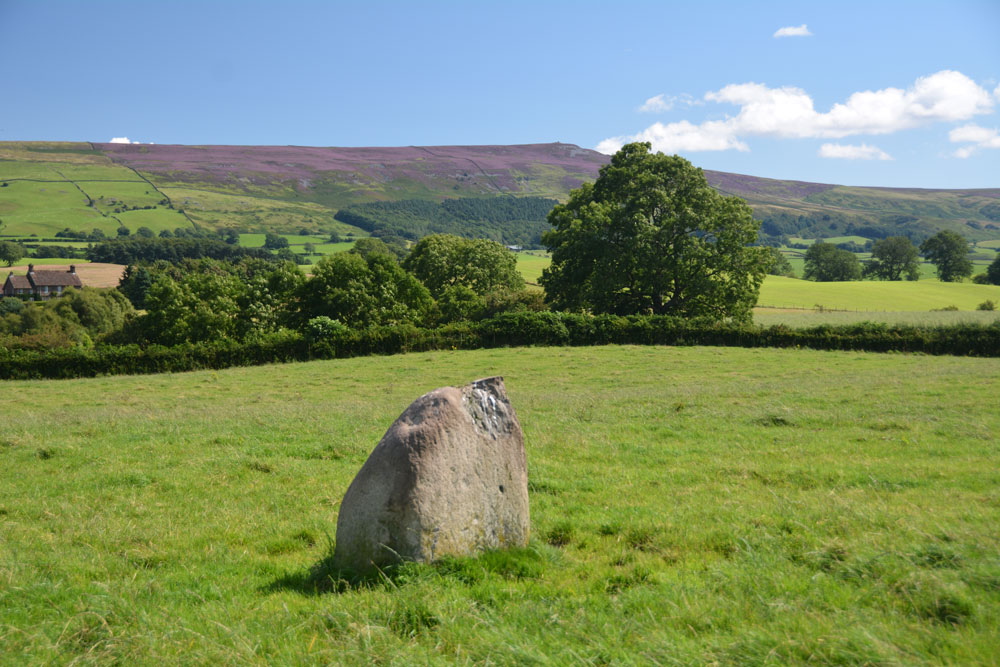
Carlatton Demesne submitted by Anne T on 18th Aug 2017. Standing on the edge of the slight mound on which the stone sits, looking south east towards Castle Carrock Fell.
(View photo, vote or add a comment)
Log Text: Carlatton Demesne Standing Stone: Following the A69 to Carlisle, the only way we could turn left off the A69 to get to Carlatton was to drive north into Brampton and back out again, under the A69. We then followed the B6413 through Castle Carrock, turning off westwards along the minor road past Moor House and Black Dub. The entrance to Carlatton Demesne Farm is around 650 metres further south of the track to Black Dub farm and there is a small hard-cored area just to the south of Carlatton Demesne Farm track, alongside the road.
At first, we walked back towards the small wood to the north-north-east to where we’d seen a gate. The gate was only held up by four pieces of wire and was very rickety, so we abandoned attempts to climb over and walked back up the farm track to where the footpath ran. I heard the farmer start his machinery up in the yard so walked along to have a word with him. It was actually a young farm worker who told me it was OK to walk through the field to look at the standing stone. He told me if we carried along the road towards Penrith, we’d get some pretty spectacular views. In the end, we retraced our steps and didn’t go down that way, but will bear that in mind for future visits.
The countryside is very pretty here, although gaining entry into the field was fun with its very muddy patch by the gate, and having stepped into the pasture, there were hidden, still soft cow pats hidden under the calf length grass. Our stone is number 4 in the list below. It appeared to be sited on top of a small, but pronounced mound with superb views around 360 degrees, with Carrock Fell to the east. It would have been a splendid setting for a stone circle.
Plotting out the points on UK Grid Reference Finder, the NGRs mentioned below form a loose alignment rather than a circle.
Rockcliffe (Cumbria)
Trip No.38 Entry No.3 Date Added: 18th Aug 2017
Site Type: Ancient Cross
Country: England (Cumbria)
Visited: Yes on 17th Aug 2017. My rating: Condition 3 Ambience 4 Access 5

Rockcliffe (Cumbria) submitted by Anne T on 18th Aug 2017. First view of the Rockcliffe Cross from the iron gates by the mounting block. It sits to the right of the path leading to the south porch.
(View photo, vote or add a comment)
Log Text: The Rockcliffe Wheel-headed Cross, Cumbria: From the centre of Carlisle, we followed the signs heading north on the A7, out to the large Asda by the M6. Just before junction 44, a road north west into the industrial estate, clearly signposted to Rockcliffe.
This road leads straight into the village, with the church being on the south western corner of the village where the minor road turns right. There is room to park by the main iron gates to the church, next to the mounting block, in a small triangular piece of road.
Immediately inside the gates, the cross is straight in front of you, just to the right of the path leading to the south porch. Nearby is a modern grave marker in a smaller, but similar shape.
The church sits on a promontory, and as you walk down to the south porch a bend of the River Eden comes into view. On the north side of the church the land drops sharply down to Rockcliffe Beck with some graves on the terrace below. Even I was intrigued enough to walk the narrow path along the northern side of the church because I wanted to see the layout of the churchyard.
Sadly the church was locked, as I’d loved to have seen inside.
Green Humbleton Settlement
Trip No.37 Entry No.5 Date Added: 8th Aug 2017
Site Type: Ancient Village or Settlement
Country: Scotland (Scottish Borders)
Visited: Yes on 6th Aug 2017. My rating: Condition 2 Ambience 4 Access 3

Green Humbleton Settlement submitted by Anne T on 8th Aug 2017. The western half of the scoop. Green Humbleton Hill can be seen just starting to rise up on the middle/upper right hand side of the image. The hillfort certainly dominated the western view.
(View photo, vote or add a comment)
Log Text: Green Humbleton Scooped Settlement, Yetholm: Now this was a settlement I could get excited about, and what views! If the first two enclosures on the way up here were somewhat dull, this more than made up for it! To the north and east the land dropped steeply away to Humbleton Syke and to the west Green Humbleton hillfort dominated the view.
By the time we got here, the wind was absolutely howling and we had to retreat to the walls of the scoop to get some respite.
There is a very clear oval scoop with a D-shaped enclosure to its north. To the north east of the D-shape there were some stones that Andrew called me over to look at. I did want to be persuaded they formed a cist. What a place to be buried. It could be a well, but there is no mention of either in the Canmore records.
If it hadn’t been so windy, I would have loved to have spent more time here. With the dark clouds looming, we decided to go up to the Stob Stones rather than risk being blown off the top of Green Humbleton hillfort. If the weather was favourable, we’d try on our way back.
Shielknowe Burn Scooped Settlement
Trip No.37 Entry No.4 Date Added: 8th Aug 2017
Site Type: Ancient Village or Settlement
Country: Scotland (Scottish Borders)
Visited: Yes on 6th Aug 2017. My rating: Condition 2 Ambience 3 Access 4
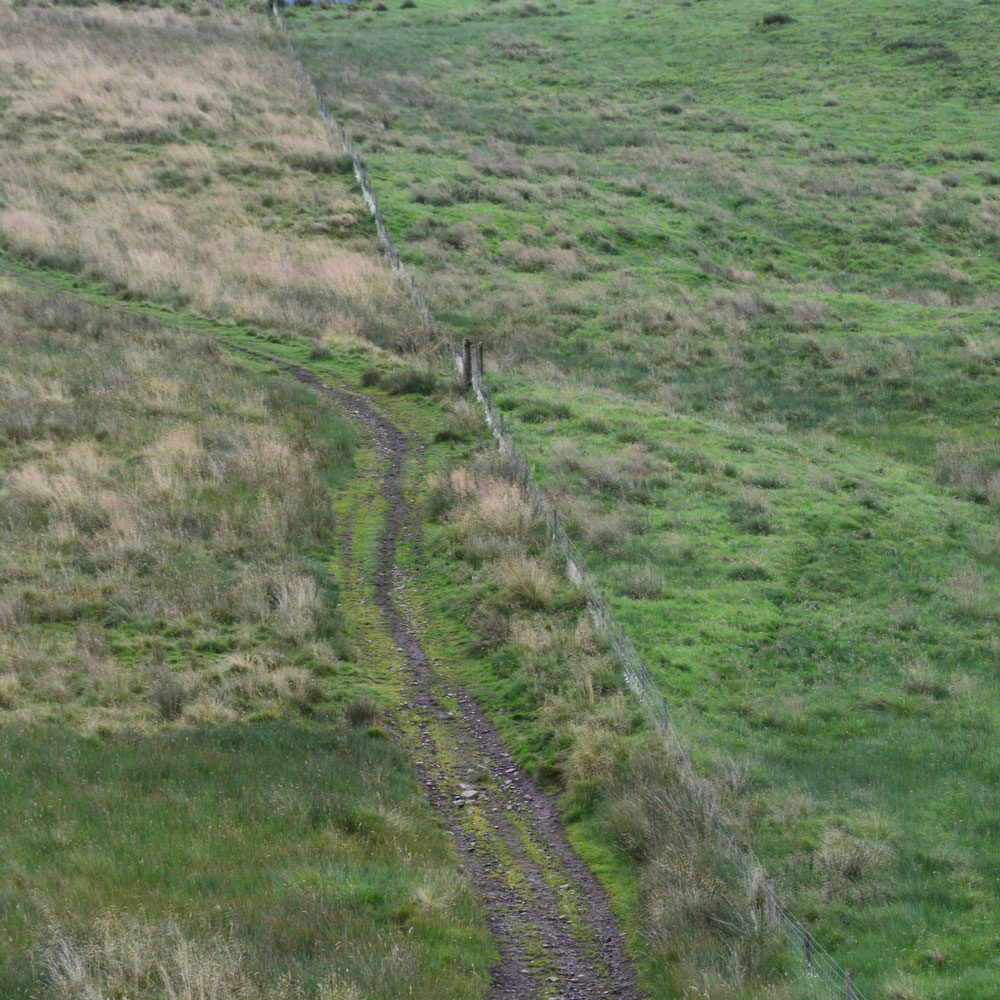
Shielknowe Burn Scooped Settlement submitted by Anne T on 8th Aug 2017. This Scooped Settlement can be seen from Shielknowe Enclosure. Its western most building platform is cut by a modern fence and St. Cuthbert's Way. Photograph taken from the almost ruined Shielknowe Enclosure to the south of Shielknowe Burn.
(View photo, vote or add a comment)
Log Text: Shielknowe Burn Scooped Settlement, Yetholm: This scooped settlement, lying on the northern side of Shielknowe Burn is much easier to see, and is visible from Shielknowe Enclosure, cut by the fence which also cuts the Enclosure. The muddy track from Shielknowe Enclosure runs downhill, crosses the burn, and leads up to join St. Cuthbert’s Way.
Two scooped out areas can be seen, although the farmer had very tightly knotted the twine securing the gate, so whilst Andrew (husband) hopped over the gate, I undid the ‘Gordion Knot’ to get into the settlement. The grass was very tussocky and wet, so walking along the banks of the western most scoop was interesting.
Much more exciting sites to come, so we didn’t spend an awful long time here.
Sheilknowe Burn Enclosure
Trip No.37 Entry No.3 Date Added: 8th Aug 2017
Site Type: Ancient Village or Settlement
Country: Scotland (Scottish Borders)
Visited: Yes on 6th Aug 2017. My rating: Condition 1 Ambience 3 Access 4
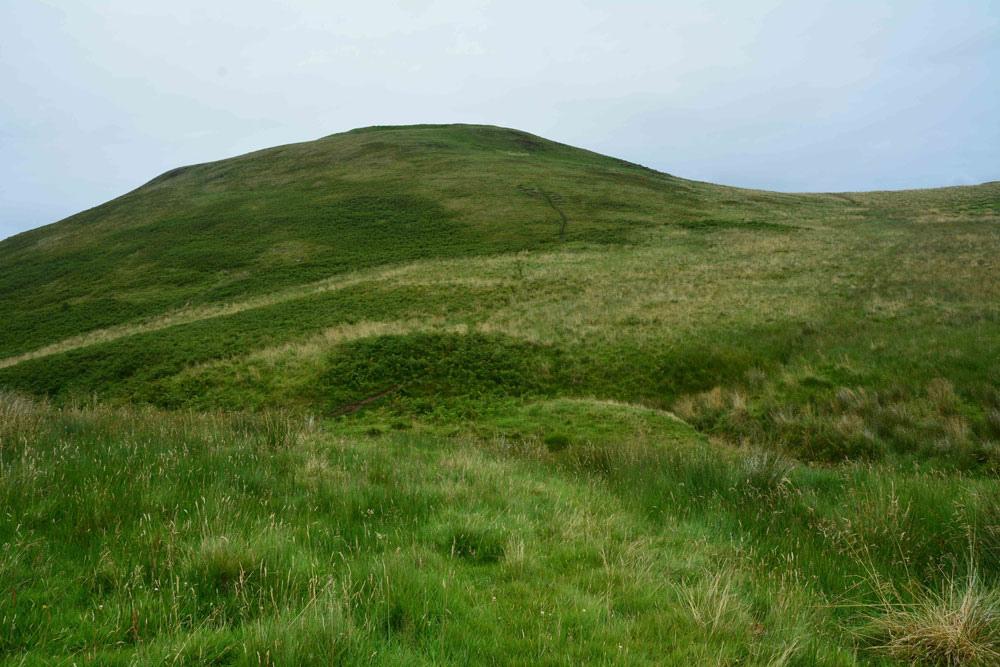
Shielknowe Burn Enclosure submitted by Anne T on 8th Aug 2017. Standing near the fence which cuts across the southern boundary of this horseshoe shaped enclosure, looking towards Shielknowe Burn, part of the land in a small loop of the burn seems to have slipped down. The burn forms the northern most boundary of the settlement. Green Humbleton hillfort is almost in the centre/top of the photograph.
(View photo, vote or add a comment)
Log Text: Shielknowe Enclosure, Yetholm: From the Virtue Well we made our way to Kirk Yetholm, finding the small side road which is actually the Pennine Way, but which can be driven down to a small parking area beside where the Halter Burn and Shielknowe Burn meet. Here a footbridge leads over the Burn, the Pennine Way and St. Cuthbert’s Way meeting at this point.
We tried St. Cuthbert’s Way first of all, running parallel to Shielknowe Burn on it’s eastern side, but after a few hundred yards, came across a rocky outcrop where I would have needed to turn into a mountain goat (OK for my husband, but not for me) so we retreated and walked almost back to the footbridge. There is another mown track which runs on the western side of the stream – boggier but much easier to follow and the sides of the small gorge not quite so precipitous.
It's a good job we had the GPS with us, together with a printed sheet of the Canmore details, otherwise we’d have walked across this settlement without knowing it was there. By finding it’s centre (the south western edge is almost at the corner of the fenced off field containing Shielknowe Burn Scooped Enclosure.
By carefully walking over the area, we could see very slight banks and changes in vegetation, but my goodness, had we not been out with NOWTAG, we would have missed this.
Stob Stones
Trip No.37 Entry No.6 Date Added: 8th Aug 2017
Site Type: Standing Stones
Country: Scotland (Scottish Borders)
Visited: Yes on 6th Aug 2017. My rating: Condition 3 Ambience 4 Access 3

Stob Stones submitted by Anne T on 7th Aug 2017. Whilst the rain lessened for a moment, the hills at the western side of the Bowmont Water Valley came briefly into view!
(View photo, vote or add a comment)
Log Text: Stob Stones, Scottish Borders: From the Green Humbleton Scooped Settlement, by the time we started climbing up towards the Stob Stones, not only was the wind was howling and I was leaning hard into it, but the rain drops were like small pins being driven into my cheeks. I confess to getting a bit fed up and wanting to turn around at this point, but a long-held desire to see these stones kept me going. It was worth it.
Walking over the Stob Rig earthworks (I stopped to photograph these on the way down), the Stob Stones are two standing stones, one now broken and lying prone, sitting on a sort of promontory as the ground to the north and west drops steeply down. Canmore says these stones are at over 1,000 ft above sea level and are situated 230 yards west of the Border. They definitely sit on some kind of mound.
To the west lies the border between England and Scotland, and we walked a 100 metres or so further up the hill, just so we could see the stone wall which makes up the boundary. Tantalisingly, we could see cairns on the adjacent hillside, but being England, different rules for walking (and I was too wet to want to go on).
Stob Rig (Yetholm)
Trip No.37 Entry No.7 Date Added: 8th Aug 2017
Site Type: Misc. Earthwork
Country: Scotland (Scottish Borders)
Visited: Yes on 6th Aug 2017. My rating: Condition 2 Ambience 4 Access 3
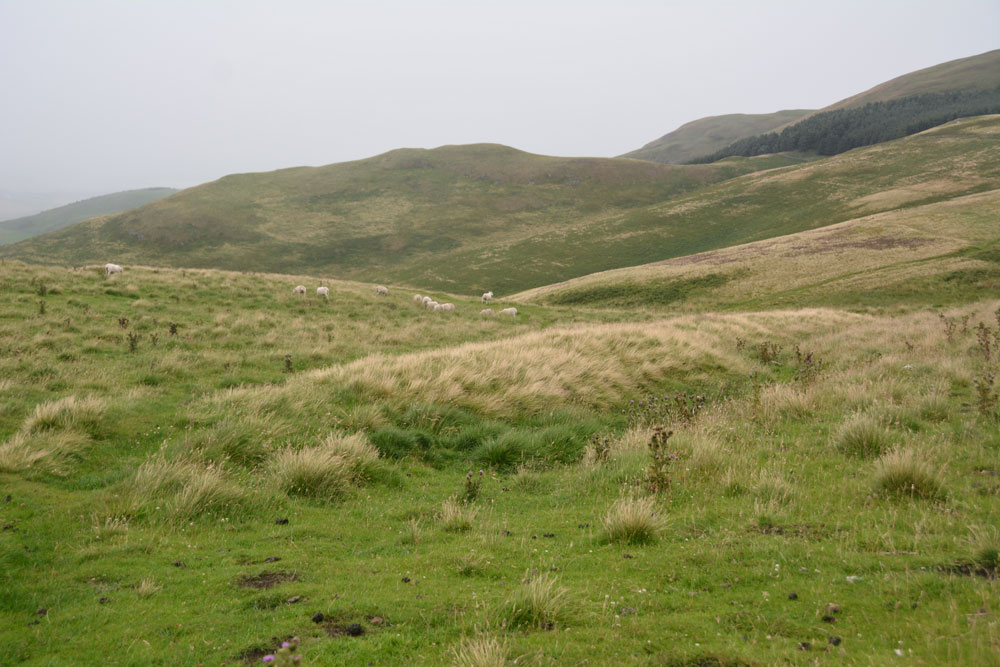
Stob Rig (Yetholm) submitted by Anne T on 7th Aug 2017. This is the eastern most of the banks with a slight ditch on its downhill side. The bank running parallel to it can be seen just on the horizon to the middle-left hand side of the photograph, delineated by the yellow grass growing on the bank.
(View photo, vote or add a comment)
Log Text: Stob Rig Earthworks: On the way up to the Stob Stones from the Pennine Way, there were two really obvious earthworks running in parallel towards the stones and we walked between them to reach the stones. I was keen to try and get out of the wind and the rain (almost impossible in this high, exposed spot) so didn't stop to photograph them.
On the way back down to re-join the Pennine Way, the earthworks were slightly less obvious. With the howling wind and the rain lashed sharply against my cheeks, I was tempted to put the camera safely in the rucksack, but having walked all this way up the hill, I wanted to document them.
In the end, I only managed to photograph the eastern most of the banks; the photos of the western-most had too many raindrops on the camera lens to be of any use.
Virtue Well (Yetholm)
Trip No.37 Entry No.2 Date Added: 7th Aug 2017
Site Type: Holy Well or Sacred Spring
Country: Scotland (Scottish Borders)
Visited: Yes on 6th Aug 2017. My rating: Condition 2 Ambience 2 Access 4
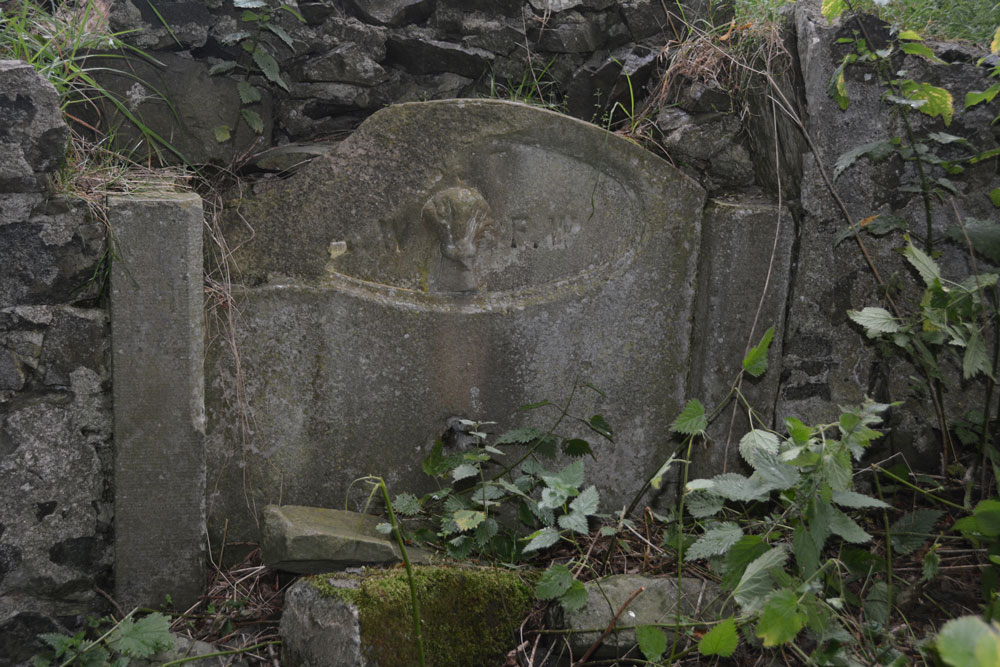
Virtue Well (Yetholm) submitted by Anne T on 7th Aug 2017. Close up of the central panel, showing the basin broken and lying at its base amongst a tumble of stones from the retaining wall.
(View photo, vote or add a comment)
Log Text: Virtue Well, Yetholm: From Venchen Farm Cottages Standing Stone, by the time we drove back down to the west side of the road bridge over Bowmont Water at NT 82132 28576, and parked at a little layby just before the road junction, the rain had eased off a little.
There were two routes up to the well, the first at NT 82128 28603 led up a wet, slippery hill towards a wood, which was rather overgrown. We opted for the footpath proper, starting at NT 82206 28645, with a proper track leading up to Braehouse Farm.
According to UK Grid Reference Finder, the path deviates through the woodland, past the well, but in real life, the track continues straight up to the farm, and we had to tramp through knee high grass through the wood.
Having found this poor little well, I couldn’t but help feel sorry for it. Such a tragedy. It reminded me of the well we’d seen in Middleham – broken up, dry and just part of an old garden wall. At least under the trees we were largely sheltered from the rain.
Venchen Farm Cottages (Town Yetholm)
Trip No.37 Entry No.1 Date Added: 7th Aug 2017
Site Type: Standing Stone (Menhir)
Country: Scotland (Scottish Borders)
Visited: Yes on 6th Aug 2017. My rating: Condition 3 Ambience 3 Access 5

Venchen Farm Cottages (Town Yetholm) submitted by Anne T on 7th Aug 2017. The Venchen Farm Cottages stone, looking south east towards Town Yetholm, over the Bowmont Water Valley. It wasn't raining (much!) when I took this photograph - that's just 'Scotch Mist' in the background.
(View photo, vote or add a comment)
Log Text: Venchen Farm Cottages Standing Stone, Scottish Borders: Having left home to avoid days of damp, rainy weather, we went in search of sunshine and blue skies. The further we travelled up the A68, the more obvious it became that the grey skies got darker the more northerly we got. As we reached Town Yetholm, the heavy raindrops started to fall with the ferocity of hail.
Venchen Farm Cottages are easy enough to find, heading north about 1.6 km north out of the village. This stone looms large out of the grassy verge; at first I thought it was just a village sign. We pulled into a small parking spot just past the stone, nearer to the cottages, by which time it was pelting down even harder and I had the camera covered with kitchen towel and handkerchiefs to keep it dry.
The Canmore notes, which we’d printed off before setting off, said that a hedge had been removed for the stone to be exposed. On UK Grid Reference Finder, the hedge can be seen with the stone tucked away behind it. The grass verge itself didn’t seem to show any signs of disturbance, considering the hedge was only removed in February this year, although the earth around the stone was visible, together with some packing stones and the vegetation along the verge was more weeds than grass.
Difficult to get photographs with the rain, but managed to keep wiping the lens.
Hawick Mote
Trip No.29 Entry No.1 Date Added: 31st Jul 2017
Site Type: Misc. Earthwork
Country: Scotland (Scottish Borders)
Visited: Yes on 3rd Jun 2017. My rating: Condition 3 Ambience 3 Access 5
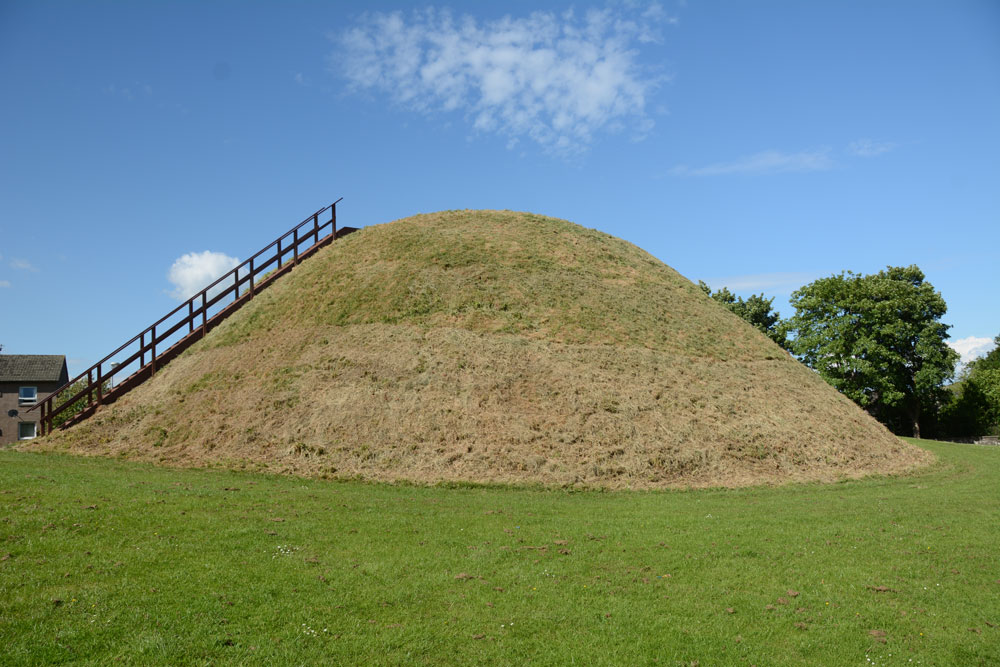
Hawick Mote submitted by Anne T on 27th Jul 2017. The Mote from the south western side, which has a ladder leading to the top of the mote which has an interpretation board.
(View photo, vote or add a comment)
Log Text: Hawick Motte/Mote, Scottish Borders: We arrived in Hawick, intending to buy a map, but the majority of the shops (apart from Dorothy Perkins, the bookmakers, charity shops and 1 café, were closed (looking at the opening times, they largely shut at 2pm on a Saturday. The town seemed deserted apart from a few tourists. We later found out that most local people had gathered near the community centre for the Riding of the Marches.
We couldn’t get a map, so relied on Andrew’s phone with TrigPoint on it. We were on our way to Lord’s Tree Cairn, driving down a street called Loan, when we spotted The Mote, so screeched to a halt by the side of the road and went round to take a photograph.
Quite extraordinary, The Mote is in the middle of a housing estate, with people’s washing hung up nearby. It rises steeply up out of the ground and there is a wooden staircase which takes you to the viewing point at the top. Andrew said it was only as large as our living room – no room for more than 12 people at most. Looking at this on UK Grid Reference Finder, it is located in Moat Park at the Southern end of the town. Plenty of dog walkers, all whom ignored me taking photographs.
The Dod
Trip No.29 Entry No.6 Date Added: 31st Jul 2017
Site Type: Ancient Village or Settlement
Country: Scotland (Scottish Borders)
Visited: Yes on 3rd Jun 2017. My rating: Condition 2 Ambience 4 Access 5

The Dod submitted by Anne T on 5th Jun 2017. The Dod settlement as seen from the slope just to the east of Burgh Hill Stone Circle.
(View photo, vote or add a comment)
Log Text: The Dod, near Bugh Hill Stone Circle and Hillfort: It was amazing what could be seen of this site from the slope just below Burgh Hill Stone Circle. Looking at the plan on Canmore, it is cut in two by the syke by the farm to it's south, but what remains, looking at the settlement from the road, are deep ditches and reasonably high banks.
The area is boggy, but the settlement can be reached by entering the field at its north-eastern end, walking westwards along the fence line next to the gate, then cutting across the field at the far end. For those not keen on boggy ground, a lot can be seen from the road.
Thankfully (after Burgh Hill Hillfort) The Dod was not windy! The sun was very strong at the time of our arrival here, and I struggled to avoid flare even using a polaroid and UV filters together. Was really pleased to have seen this site, but with so many other settlements and hill forts in the area, how to fit them all in? We decided to call it a day, calling in at Midshiels Standing Stone and Cairn on the way back home.
Burgh Hill Hillfort
Trip No.29 Entry No.5 Date Added: 31st Jul 2017
Site Type: Hillfort
Country: Scotland (Scottish Borders)
Visited: Yes on 3rd Jun 2017. My rating: Condition 3 Ambience 5 Access 3
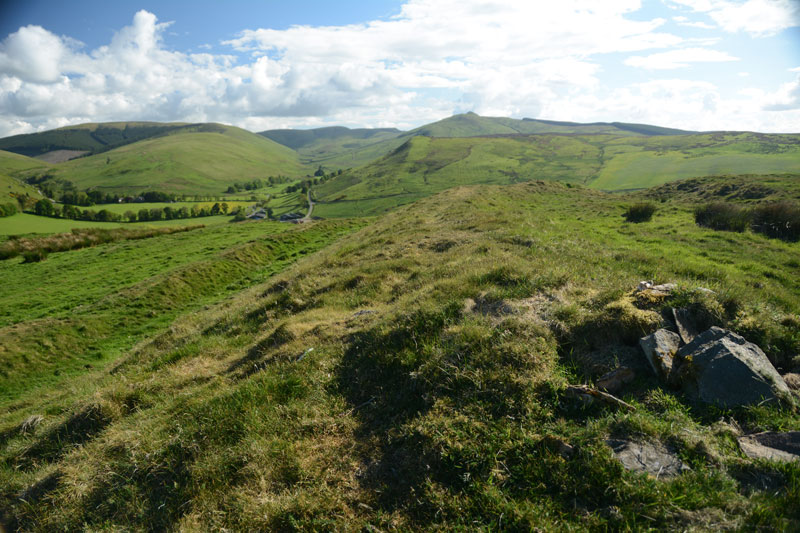
Burgh Hill Hillfort submitted by Anne T on 5th Jun 2017. Standing half way along the eastern upper bank of the fort, looking south west towards the hills beyond.
(View photo, vote or add a comment)
Log Text: Burgh Hill Hillfort, Scottish Borders: What is a 'bit more of a walk' for me is probably a 'short walk on a footpath' for others, but even so, this was a brilliant place to have visited.
With Burgh Hill Stone Circle (or possibly a cairn circle?) not far away, it was worth the additional short trek up to the south west summit of Burgh Hill. Goodness it was windy, although thankfully, as it was a nice warm spring/summer day, the wind was at least warm.
On the western side of the hillfort, the ground (as at Woden Law) dropped away sharply, making me take a quick step backwards to admire the views over the Allan Water valley below.
There are clear internal boundaries/banks/walls and a couple of hut circles, although these didn't come out very clearly on the photographs I took. There was a solitary large (standing) stone which didn't seem to be associated with any internal features.
The double banks and ditches on the south, east and northern sides of the fort were really visible, made of stone and earth, with two clear entrances to the north-east and south-west.
Burgh Hill Stone Circle
Trip No.29 Entry No.4 Date Added: 31st Jul 2017
Site Type: Stone Circle
Country: Scotland (Scottish Borders)
Visited: Yes on 3rd Jun 2017. My rating: Condition 3 Ambience 4 Access 3
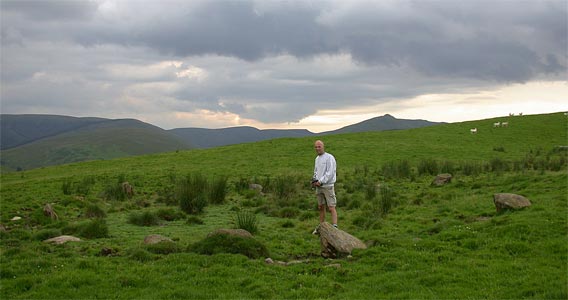
Burgh Hill Stone Circle submitted by nicoladidsbury on 17th Mar 2004.
(View photo, vote or add a comment)
Log Text: Burgh Hill Stone Circle, Hawick: After visiting Lord's Tree and Ca Knowe Cairns, we headed off towards Teviothead and some wild, lonely countryside. There is a track leading up the hill towards the stone circle (and the hill fort beyond), at NT 47365 06725, with parking for 2-3 cars opposite.
Following the track up the (reasonably steep) hill, we took the left hand fork and followed the mowed grassy track towards the stone circle. The circle lies just past the first peak with rocks outcrops to your right, but not as far as the fort. We went past the stones at first, having climbed too high up the hill, but Andrew found a metal pole with a large aluminium star attached to it, presumably marking this as an archaeological site.
Looking at the site on UK Grid Reference Finder, the circle lies in between two small banks running in very shallow arcs. The stones of the circle seem to lie in a dip with a small bank around. It reminded me very much of a cairn circle rather than a stone circle, as none of the stones seemed to be worked in any way, and they were all comparatively small. I note the Canmore record for this site says it's been re-designated a Stone Setting rather than a stone circle.
Having stayed to enjoy the views, and also photograph the Dod settlement from above, we climbed up to the fort, where it was VERY windy (but thankfully the wind was warm).
Midshiels Standing Stone
Trip No.29 Entry No.7 Date Added: 31st Jul 2017
Site Type: Standing Stone (Menhir)
Country: Scotland (Scottish Borders)
Visited: Yes on 3rd Jun 2017. My rating: Condition 3 Ambience 4 Access 4

Midshiels Standing Stone submitted by Anne T on 4th Jun 2017. This is the nearest we could get to the standing stone on the evening of our visit. The field was full of quietly grazing sheep but many lively, curious young bullocks. The minute we started to open the gate, they were racing towards us.
(View photo, vote or add a comment)
Log Text: Midshiels Standing Stone, Hawick: We'd arrived (unknowingly) in Hawick on their Riding of the Marches day. The shops were shut and the town was almost deserted. Having visited some other sites on the southern side of Hawick, we decided to stop off to see this standing stone and cairn on the way back home. Following the curious one-way system though Hawick, we ended up on the Borders Abbey Way heading north-east out of the town. At Bucklands, we found where the entire town was - at a community centre at the edge of the town. A marshall stopped us and told us we wouldn't be able to get any further up the road as the procession of horses was coming through. Doubling back through the industrial estate, we took the A698 out of town, turning left over the picturesque Hornshole Bridge, rejoining Borders Abbey Way a few hundred yards before the entrance to Midshiels Farm.
A couple of hundred yards further north-east along the road, there was a large passing place, so we hugged the car into the hedgerow and hopped out. About 50 metres further back, on the other side of the road, a gate let us into the field leading to the dismantled railway embankment to the west. Following the left hand hedge-line along, we came to another gate, just before a tall brick bridge leading under the railway line. This gate gave access to the field with the standing stone and cairn.
However, the field was full of gently grazing sheep and lots of lively, curious bullocks along with what looked like a very large bull. My hand went onto the gate and they were running towards us. I elected to use the zoom lens on the camera, and was really disappointed not to have seen this standing stone closer up. But there is lots to see in this area, so undoubtedly a return visit will be in the offing at some point in the not too distant future.
Ca Knowe (Hawick)
Trip No.29 Entry No.3 Date Added: 31st Jul 2017
Site Type: Cairn
Country: Scotland (Scottish Borders)
Visited: Yes on 3rd Jun 2017. My rating: Condition 2 Ambience 4 Access 4
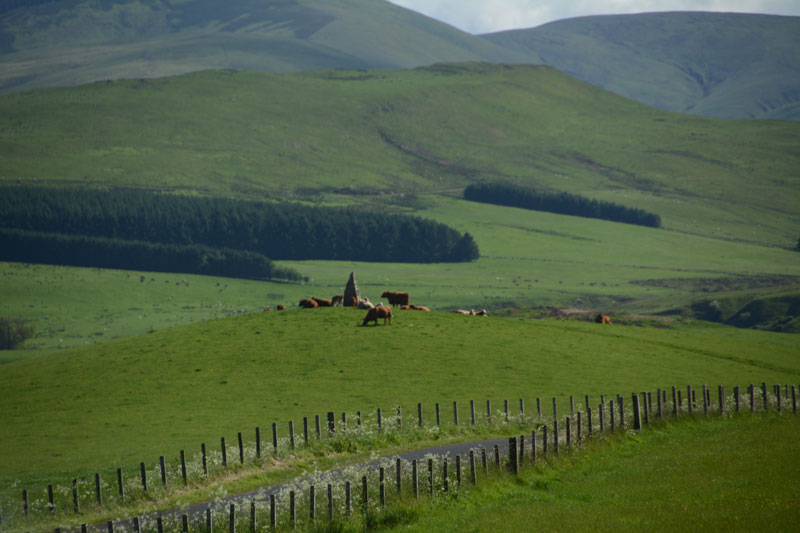
Ca Knowe (Hawick) submitted by Anne T on 4th Jun 2017. Ca Knowe Cairn from Lord's Tree Cairn.
(View photo, vote or add a comment)
Log Text: Ca Knowe Cairn, Hawick (aka Hero's Grave): Simply marked as ‘cairn’ on Trigpointing UK's OS map, we could see this cairn from Lord’s Tree Cairn. There is a proper tarmacked footpath up to the modern standing stone with plaque on it. Closer to, it is much larger than it appears from the mark on the map, and has a proper tarmacked path up to it.
Unfortunately, both on our way to our next site, and our way back to Hawick, the monument was surrounded by a number of very large cows with their calves, so we decided not to risk upsetting them and drove on after having taken some photographs.
Lord's Tree (Hawick)
Trip No.29 Entry No.2 Date Added: 31st Jul 2017
Site Type: Cairn
Country: Scotland (Scottish Borders)
Visited: Yes on 3rd Jun 2017. My rating: Condition 3 Ambience 4 Access 4
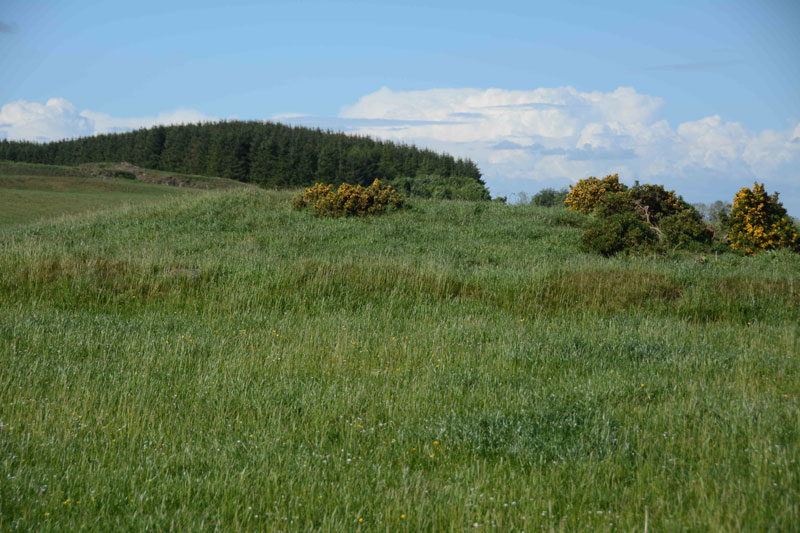
Lord's Tree (Hawick) submitted by Anne T on 4th Jun 2017. Standing at the southern side of the cairn looking up the slight slope to the low mound of the cairn. The circular bank around the cairn clearly visible.
(View photo, vote or add a comment)
Log Text: Lord's Tree Cairn, Hawick: We arrived in Hawick, intending to buy a map, but the majority of the shops (apart from the bookmakers, charity shops and 1 café, were closed (looking at the opening times, they largely shut at 2pm on a Saturday. The town seemed deserted apart from a few tourists. We later found out that most local people had gathered near the community centre for the Riding of the Marches.
Relying upon the Trigpointing UK maps (good job there was a phone signal!), we navigated our way through the town (stopping off to look at The Mote on the way), past the golf course and out into the glorious open countryside with the hills beyond.
This cairn appears as a slight bump at the top of a small rise of a hill; it's unmistakably a large, low cairn, and the lush green grass and wild flowers invited a walk through the meadow towards it.
Completely circular, there is a low bank surrounding the cairn. Shame the old Lord's Tree wasn't there. Lovely view down to Ca Knowe Cairn further south.
Carey Burn (Harthope Valley)
Trip No.36 Entry No.4 Date Added: 31st Jul 2017
Site Type: Ancient Village or Settlement
Country: England (Northumberland)
Visited: Yes on 30th Jul 2017. My rating: Condition 1 Ambience 2 Access 4

Carey Burn (Harthope Valley) submitted by Anne T on 31st Jul 2017. Looking westwards up Snear Hill to the second scooped settlement, which wasn't marked on the OS map. The western bank of this settlement can be seen running across the middle of the photograph, left to right.
(View photo, vote or add a comment)
Log Text: Carey Burn Votadinian settlement, Harthope Valley: After the beautiful Maiden/Pin Well, I got stuck on a 'precipice' above the Coldgate Burn trying to get to the Romano-British settlements to the west of North Middleton and bottled out (my dreaded fear of falling - I've subsequently found the map showed a low level, apparently straightforward footpath from North Middleton, although it was about a mile either way). After this experience, I need to try and regain my composure.
On the map, just across the road from the footpath we’d tried, and just west of Carey Burn Bridge, a track ran up the hill at NT 97513 24937, just above a currently empty barn. A settlement was shown here. An NNPA footpath ran up the hill, so we opened the gate and followed the path up.
We did find the settlement, but it looked as if a fence had recently been installed along the north western bank, crossing over part of it to the eastern side.
A long, low earth and stone bank about 1 metre tall and 2 metres wide ran parallel to the fence from NT 97353 24907 to NT 97301 24938 then curves around to the Carey Burn at NT 97337 25012. This bank can be seen on UK Grid Reference Finder.
On getting home, I discovered from Pastscape that the settlement we looked at was classed as Votadinian. There is a second settlement, which isn’t marked on the map at NT 97132488, which is further up the hill.
